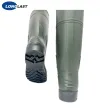Safety boots play a crucial role in protecting workers from various occupational hazards. Whether you're working on a construction site, in a factory, or any other potentially dangerous environment, the right pair of safety boots can make a significant difference. In this article, we will address five of the most common questions about safety boots, providing insights and guidance for those seeking to enhance their safety footwear knowledge.
Can Safety Shoes Actually Protect You Against Serious Hazards?
Absolutely. Safety shoes are designed to provide protection against a range of workplace hazards. Depending on the industry, safety boots can safeguard against impacts, punctures, electrical hazards, and more. The key lies in selecting the right type of safety footwear that aligns with the specific risks associated with your job. Steel-toe boots, for example, offer excellent protection against heavy objects, while electrical hazard boots provide insulation against electrical shocks.
How Can I Stop the Inside of the Heels of Shoes Wearing Away So Quickly?
Premature wear on the inside of the heels can be frustrating and uncomfortable. To mitigate this issue, consider the following tips: a. Proper Sizing: Ensure your safety boots fit correctly. Ill-fitting boots can cause uneven wear. b. Quality Insoles: Invest in high-quality insoles to provide additional support and reduce friction. c. Regular Maintenance: Keep your boots clean and inspect them regularly for signs of wear. Promptly replace worn-out insoles or heels to extend the life of your safety boots.

When Are Safety Boots Needed?
Safety boots are necessary in various work environments where foot protection is crucial. Some common scenarios include: a. Construction Sites: Protection against heavy falling objects, sharp materials, and uneven surfaces. b. Industrial Settings: Shielding against machinery, chemicals, and electrical hazards. c. Manufacturing Facilities: Guarding against potential foot injuries from heavy equipment or tools. d. Warehouses: Preventing injuries from falling objects and providing stability on slippery surfaces.
What Is the Difference Between Work Boots and Safety Boots?
While the terms are often used interchangeably, there is a subtle difference. Work boots are a broader category that includes various styles suitable for different jobs. On the other hand, safety boots specifically refer to footwear designed with protective features, such as steel toes, metatarsal guards, and slip-resistant soles. In essence, all safety boots can be considered work boots, but not all work boots have the added safety features.
How To Make Your Safety Boots Comfortable
Comfort is crucial for ensuring that workers wear their PVC safety boots consistently. Follow these tips to enhance the comfort of your safety boots a. Choose the Right Size: Ensure your boots fit properly to prevent discomfort and blisters. b. Break Them In: Allow time for your boots to conform to the shape of your feet by wearing them for short periods initially. c. Quality Socks: Invest in moisture-wicking, cushioned socks to reduce friction and enhance comfort. d. Regular Cleaning: Keep your boots clean and free from debris, as dirt and grime can contribute to discomfort.
Conclusion
Understanding the importance of safety boots and addressing common concerns about their functionality and comfort is essential for promoting workplace safety. By selecting the right safety footwear and taking proper care of them, workers can minimize the risk of injuries and ensure a comfortable and productive work experience.





Comments
All Comments ( 0 )